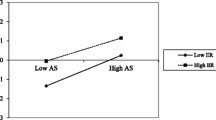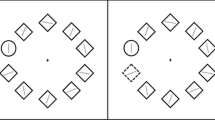Abstract
Anxiety sensitivity (AS) refers to the tendency to interpret anxiety related physical sensations as dangerous (S. Reiss & R. J. McNally, 1985). We hypothesized that individuals with elevated AS would show a difficulty in inhibiting the threat relevant meaning of homographs (words with two meanings, e.g., faint). To test this hypothesis, we used a modified version of Gernsbacher's inhibition paradigm in which participants were first presented with a sentence (e.g., “The car sounds were faint.”) and then a probe word (e.g., “pass-out”) and were asked whether or not the probe word was related to the meaning of the sentence (M. A. Gernsbacher, K. R. Varner, & M. E. Faust, 1990). One half of the sentences ended in a homograph, and one half ended in a nonhomograph word. Results revealed that individuals with elevated AS showed difficulty in inhibiting the threat-relevant meaning of homographs when the interval between the presentation of the sentence and the probe word was short (i.e., 100 ms), but that low AS participants did not. This difficulty in inhibiting threat relevant meanings may be a vulnerability factor involved in elevated AS, as well as the development of panic disorder.
Similar content being viewed by others
REFERENCES
American Psychiatric Association. (1994). Diagnostic and statistical manual of mental disorders (4th ed., rev.).Washington, DC: Author.
Amir, N., Coles, M., & Foa, E. B. (2002). Inhibition of threat in posttraumatic stress disorder. Cognitive Research and Therapy, 26, 645–655.
Amir,N., Foa, E. B., & Coles, M. E. (1998). Automatic activation and strategic avoidance of threat-relevant information in social phobia. Journal of Abnormal Psychology, 107, 285–290.
Amir, N., McNally, R. J., Riemann, B. C., & Clements, C. (1996). Implicit memory bias for threat in panic disorder: Application of the white noise paradigm. Behaviour Research and Therapy, 34, 157–162.
Beck, A. T.,& Steer, R. A. (1987). Beck Depression Inventory manual. San Antonio, TX: The Psychological Corporation.
Faust, M. E., Balota, D. A., Duchek, J. M., Gernsbacher, M. A., & Smith, S. (1997). Inhibitory control during sentence comprehension in individuals with dementia of the Alzheimer type. Brain and Language, 57, 225–253.
Garber, J., & Hollon, S. D. (1991). What can specificity designs say about causality in psychopathology research? Psychological Bulletin, 110(1), 129–136.
Gernsbacher, M. A., Varner, K. R., & Faust, M. E. (1990). Investigating differences in general comprehension skill. Journal of Experimental Psychology: Learning, Memory, and Cognition, 16, 430–445.
Holloway, W., & McNally, R. J. (1987). Effects of anxiety sensitivity on the response to hyperventilation. Journal of Abnormal Psychology, 96, 330–334.
McCabe, R. E. (1999). Implicit and explicit memory for threat words in high-and low-anxiety-sensitive participants. Cognitive Therapy and Research, 23, 21–38.
McNally, R. J. (1999) Anxiety sensitivity and information-processing bias for threat. In S. Taylor (Ed.), Anxiety sensitivity: Theory, research, and treatment of the fear of anxiety (pp. 183–198). Mahwah, NJ: Erlbaum.
McNally, R. J., Hornig C.D., Hoffman E. C., & Han, E. M. (1999). Anxiety sensitivity and cognitive biases for threat. Behavior Therapy, 30, 51–61.
Rapee, R. M., & Medoro, L. (1994). Fear of physical sensations and trait anxiety as mediators of the response to hyperventilation in nonclinical subjects. Journal of Abnormal Psychology, 103, 603–699.
Reiss, S., & McNally, R. J. (1985). Expectancy model of fear. In S. Reiss & R. R. Bootzin (Eds.), Theoretical issues in behavior therapy (pp. 107–121). New York: Academic Press.
Reiss, S., Peterson, R. A., Gursky, D. M., & McNally, R. J. (1986). Anxiety sensitivity, anxiety frequency and the prediction of fearfulness. Behaviour Research and Therapy, 24, 1–8.
Schacter, D. L. (1992). Understanding implicit memory: A cognitive neuroscience approach. American Journal of Psychology, 4, 559–569.
Schmidt, N. B., Lerew, D. R., & Jackson, R. J. (1997). The role of anxiety sensitivity in the pathogenesis of panic: Prospective evaluation of spontaneous panic attacks during acute stress. Journal of Abnormal Psychology, 106, 355–364.
Schneider, W. (1988). Micro Experimental Laboratory: An integrated system for IBM PC compatibles. Behavior Research Methods, Instruments, and Computers, 20, 206–217.
Spielberger, C. D., Gorsuch, R. L., Lushene, R., Vagg, P. R., & Jacobs, G. A. (1983). Manual for the State-Trait Anxiety Inventory. Palo Alto, CA: Consulting Psychologist Press.
Van Petten, C., & Kutas, M. (1987). Ambiguous words in context: An event-related potential analysis of the time course of meaning activation. Journal of Memory and Language, 26, 188–208.
Zwaan, R. A., & Truitt, T. P. (2000). Inhibition of smoking-related information in smokers and nonsmokers. Experimental and Clinical Psychpharmacology, 8, 192–197.
Author information
Authors and Affiliations
Corresponding author
Rights and permissions
About this article
Cite this article
Amir, N., Beard, C. Inhibitory Difficulties and Anxiety Sensitivity. Cognitive Therapy and Research 28, 283–292 (2004). https://doi.org/10.1023/B:COTR.0000031803.85597.aa
Issue Date:
DOI: https://doi.org/10.1023/B:COTR.0000031803.85597.aa




